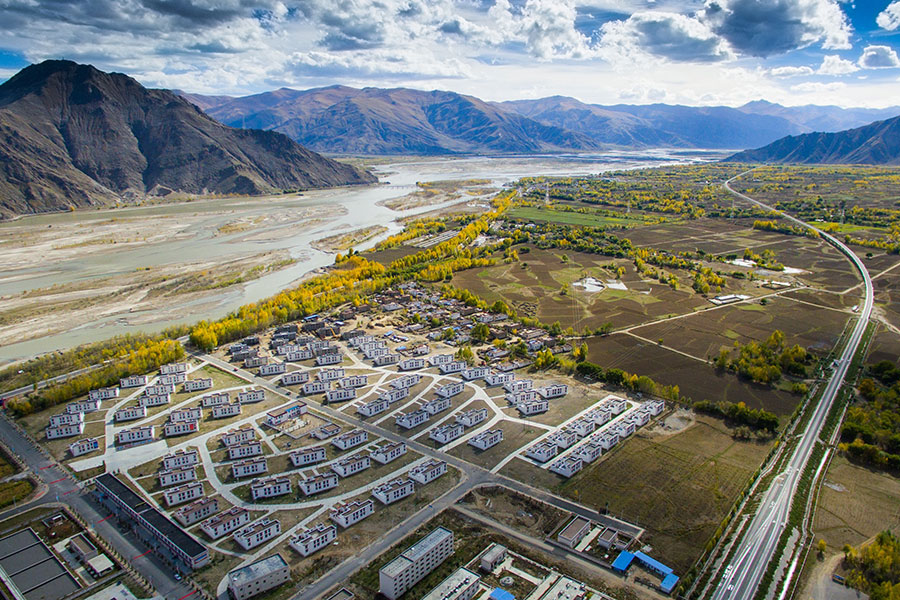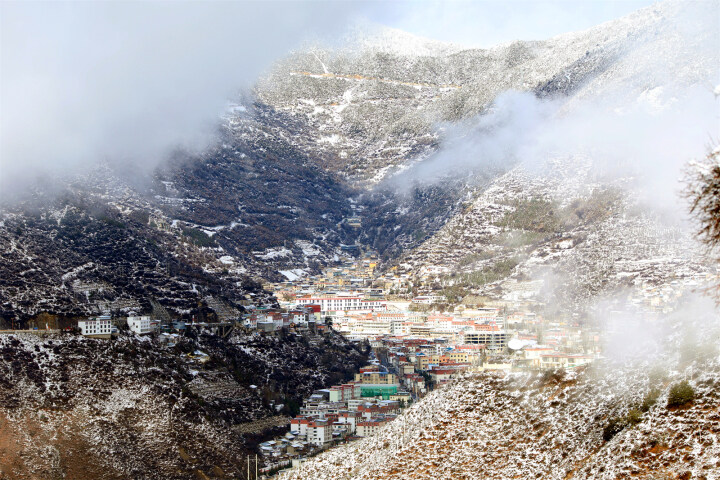
The Sanyou village in Chushul county, Tibet autonomous region, is home to 184 families of more than 700 Tibetan people, who were once impoverished. [Photo/Xinhua]Region has witnessed transformations in seven decades since peaceful liberation The vision set out by President Xi Jinping on the governance of the Tibet autonomous region has been instrumental in the region's phenomenal transformation, and it will continue to chart the course for the region's ethnic unity, lasting stability and high-quality growth, said observers and local residents. This year marks the 70th anniversary of the peaceful liberation of Tibet. The region has undergone a process of dramatic change over the past seven decades from a society of serfdom to the elimination of poverty among all of its residents, who now have access to quality healthcare, free education and housing. In a strong gesture of support to the region, Xi, who is also general secretary of the Communist Party of China Central Committee, made a landmark visit to the region last month, marking the first time that a top Chinese leader has taken part in the celebration of the peaceful liberation in the history of the Party and the country. Xi also visited Tibet in 2011 when the region was celebrating the 60th anniversary of its peaceful liberation. Xi, who then served as China's vice-president, led a delegation to take part in the celebration. Wang Yang, a member of the Standing Committee of the Political Bureau of the CPC Central Committee and chairman of the National Committee of the Chinese People's Political Consultative Conference, arrived in Lhasa on Wednesday with a delegation to attend festivities celebrating the 70th anniversary. Kelsang Drolma, a researcher on Tibetan economy and society with the China Tibetology Research Center, said Xi's visit in July was another indicator of the strong emphasis given by the Party and Xi himself to the region's development. Since Xi's election as general secretary of the CPC Central Committee in 2012, the Party has elevated the strategic status of Tibet to an unprecedented level. The president spoke twice at high-level symposiums on Tibet-related work, in 2015 and 2020, setting out priorities for the region's development strategies in the new era. He has also replied to letters from shepherds and medical majors at Tibet University and issued key instructions on the region's poverty alleviation, scientific exploration, border development and the start of construction of the Sichuan-Tibet Railway. "Under this guidance, Tibet has solved many problems that it has long tried to solve but could not, and accomplished matters that it has long tried to accomplish but could not," said Chen Pu, deputy director of the institute of economic strategy at the Tibetan Academy of Social Sciences. He noted that the region has led the nation's economic growth since 2012, with Tibet's economic structure further optimized and its transport network improved. Tibet's economy has shifted from high-speed growth to high-quality growth in recent years, with its GDP reaching 190 billion yuan ($29.32 billion) in 2020, up from 70.1 billion yuan 2012. The per capita disposable income of rural Tibetan residents was 14,598 yuan in 2020, up from 5,645 yuan in 2012. By the end of 2019, all of Tibet's 74 impoverished counties had been removed from the list of poverty-stricken areas, with over 620,000 people lifted out of penury. The region's average life expectancy was 71.1 years in 2020, compared with an average of 35.5 years before its liberation, with residents now offered a 15-year free education program. Sonam Palzom, a 35-year-old Tibetan villager from the region's Lhundrub county, said her family's life has been reshaped over the past decade, as the government ramped up efforts on poverty alleviation. She explained that her family was mired in poverty as her mother was its only breadwinner after her father passed away early, and they barely had enough to eat or wear. Living on the foot of a mountain, the family would have to make a journey of at least one hour to fetch water from a spring. Without access to electricity, the family had to rely on candles for lighting, she recalled. As the poverty alleviation efforts moved forward, Sonam Palzom's family was relocated to a new building with bedrooms for each of the family members, in an area with paved roads. "Our life is getting better and better. All my siblings are now faring well. We feel keenly that we owe it to the investments from the Party and the government in public well-being," she said. Kelsang Drolma, the researcher, said a people-centered development philosophy has always been the main thrust of the Party's governance strategy over the past seven decades. Going forward, she said the new vision Xi set out during his July trip, in which he called for steps to ensure that growth will help improve the sense of gain, happiness and security of people of various ethnic groups, will continue to guide the region's development. "Infrastructure development will continue to be the key focus for the government to improve people's well-being. And the development of human resources through education could be another priority," she said. Some analysts have also noted that Xi's vision for ecological and environmental protection is now resonating strongly among people in Tibet, with the region's People's Congress last year adopting a regulation to develop it into a leading area for ecological civilization. Xi has stressed on many occasions the importance of protecting the environment of the Qinghai-Tibet Plateau, saying that environmental protection must come first and this would be a major contribution to the existence and development of the Chinese nation. Tibet remains one of the regions with the best environment in the world, with forest coverage of 12.3 percent. Source: China Daily Global |






7740f3b5-9ecb-438e-9052-76cb2d4bb671.jpg)

